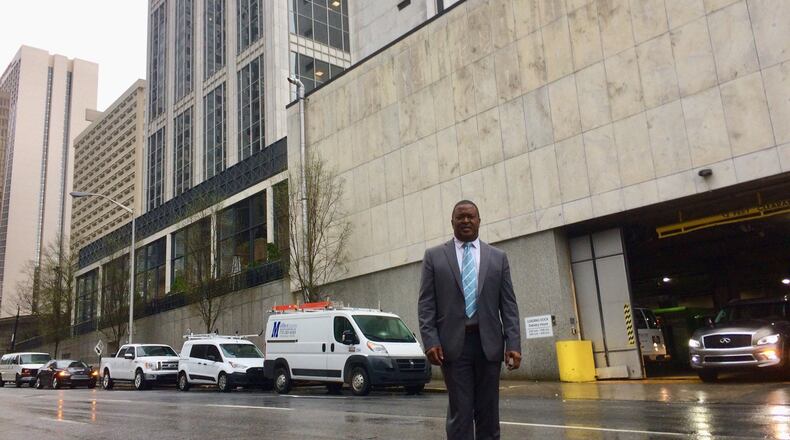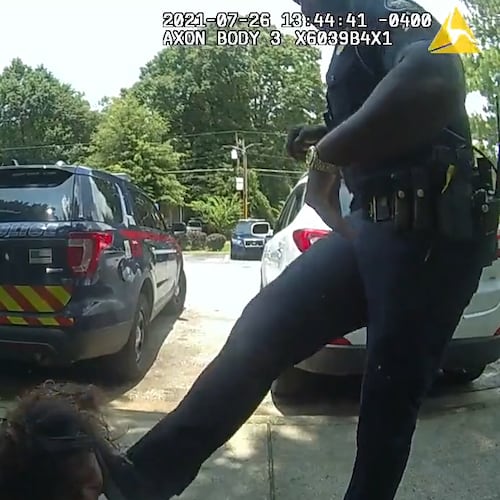As currently configured, Baker Street in downtown Atlanta serves as an efficient funnel to move cars to and from the interstate.
The four-lane, one-way road resembles a dystopian, Portmanesque 1960s thoroughfare, one lined with large hotels, the SunTrust headquarters (for now), the massive AmericasMart center and little sidewalk buzz.
But it works. And now some business proprietors, residents and others along that half-mile stretch of road worry the city is going to screw that up.
The city of Atlanta wants to turn the road back into a two-way street, like it was in 1941 or the early 1960s — there’s conflicting reports on when it was converted. The city wants to do this all over downtown, reconverting more than 6 miles of one-ways. It’s a page out of New Urbanism, a hunch that if you switch the streets back to two-way, good things will follow.
One-way streets are "a hugely impactful thing," said Atlanta's planning czar Tim Keane. "They were put in place so we could get cars in and out of town as fast as we can. The effect of that has been devastating to downtown."
The idea is that two-way streets allow people more access to businesses, that cars will slow down, that people might start biking, walking or scootering on those streets, and that living, working and playing will break out all over the place.
“It’s a broader philosophical shift in many American cities,” said Councilman Amir Farokhi, who represents part of that area of downtown and likes the idea. “It’s shifting the character of streets, making them more lively. It’s a destination, not a pass-through.
“No one wants to open a store, eat lunch or walk with their kids along a one-way road with cars speeding by.”
But getting cars to move is not necessarily a bad thing, especially in a city where being gridlocked is a grim local pastime.
A fellow named Matthew Peterson has been the front man for the opposition to the change. Peterson operates a car washing business in the bowels of a building at 260 Peachtree St., which has a key entrance along Baker St. He has lobbied officials at City Hall, accumulated reports and studies, and rallied opponents.
Hundreds of vehicles park in the building and enter and exit efficiently because of the one-way. Currently, vehicles making a left turn out of the building flow into the one-way westbound traffic on Baker Street. If the street becomes two-way, then those cars would have to cross a lane of eastbound traffic, creating a quagmire, he said.
Off-duty cops would have to be hired to move cars from businesses. But what often happens in those cases is that officers look out for their client, not necessarily smooth traffic flow.
Hotels also worry about the loading and unloading in their buildings, since one of the four lanes has become a de facto loading zone.
Peterson said he used to work in the parking operation at the Hyatt Regency down the street and said the three massive hotels along Baker — the Marriott, Hyatt and Hilton — all host events that dump lots of vehicles onto the roads all at once.
“When you have 2,000 people come out of the Hyatt, they need to get to the highway,” said Peterson. “When there’s large events, cars still get backed up in the garage.”
That will get worse, said a traffic engineering report prepared by Speedy Boutwell (yes, that is his name) of Wilburn Engineering. That report was prepared for Richard Bowers, a real estate tycoon whose building sits along Peachtree and Baker and who appears to be the opposition’s leader.
According to Speedy’s analysis, “Parking garage access along Baker Street houses over 6,500 covered parking spaces. The entrances and exits will be adversely affected by the proposed two-way conversion.” Later, he added, “Businesses along this section … have cultivated and shaped their community around one-way operation.”
The added number of left turns in a two-way configuration would increase crashes, he said.
The work will cost about $1.3 million and is on the Renew Atlanta list of projects to get done. The problem is that Atlanta has more than $1 billion in infrastructure needs and Renew's funding (that comes from a sales tax) will raise at most $300 million. And much of that has already been spent, meaning officials are left making hard choices about what makes the cut and what doesn't. Obviously, most doesn't.
At a City Council committee meeting last week, Josh Rowan, who was hired this year to help salvage the Renew program, told council members that Baker Street is underutilized for most of the day and that its conversion “fits with the overall theme of downtown.”
It would be downtown's first conversion of a one-way street. Other streets on downtown's master planwish list are John Portman Boulevard, Andrew Young International Boulevard, Ellis Street, Centennial Olympic Parkway, Ted Turner Drive, Peachtree Center Avenue and Mitchell Street.
An engineering report completed for the city said the “holistic benefits” of the conversion can be achieved “without significantly impacting traffic operations along Baker Street” and would relieve bottlenecks on nearby roads such as Ivan Allen Jr. Boulevard at Williams Street.
Well, seems like we have a traffic engineering “he said/she said” here. The Federal Highway Administration, too, is split on which is best.
Richard Florida, an urban theorist and bestselling author, wrote an article last year looking at a study of one-way street conversions. Again, mixed bag. A San Francisco researcher looked at six cities and the areas around such conversions.
“Street conversions led to an increase in jobs in just two of the six,” Florida wrote. The others saw drops in jobs in the surrounding areas.
“In most places, two-way streets appear to make neighborhoods safer and more livable,” he wrote. “But, in doing so, they also appear to go hand in hand with the broader process of neighborhood upgrading and gentrification.”
The City Council takes up this issue today.
About the Author
The Latest
Featured





